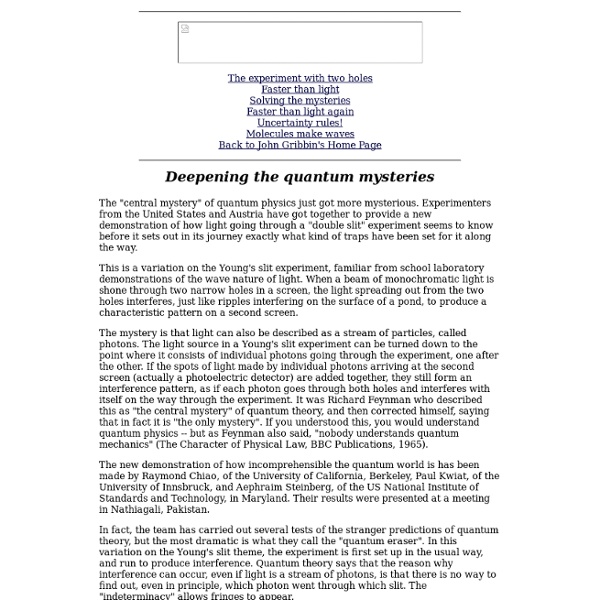David Grayson's blog: Using I²C on the Raspberry Pi
Last night I succeeded in getting my Raspberry Pi to do some basic I²C (also known as I2C, TWI, or SMBus) communication. I had to look around in a couple different places on the web to figure out how to do it, so I thought I would make this blog post to consolidate the knowledge. The first step, of course, is to set up an SD card suitable for the Raspberry Pi. I used the official Debian image from the Raspberry Pi Foundation. Unfortunately, this official image has no support for I²C! Once you are running the new kernel, you will need to run sudo modprobe i2c_dev. pi@raspberrypi:~/$ ls -l /dev/i2c* crw------- 1 root root 89, 0 Dec 31 1969 /dev/i2c-0 crw------- 1 root root 89, 1 Dec 31 1969 /dev/i2c-1 You will need to connect your device to the Raspberry Pi. When I ran this code, it printed 0x3C which means that it successfully talked to the device! In conclusion, it was not too hard to get I²C working on the Raspberry Pi.
Physics for the 21st Century
Course Overview Welcome to Physics for the 21st Century: an on-line course that explores the frontiers of physics. The 11 units, accompanied by videos, interactive simulations, and a comprehensive Facilitator's Guide, work together to present an overview of key areas of rapidly-advancing knowledge in the field, arranged from the sub-atomic scale to the cosmological. The goal is to make the frontiers of physics accessible to anyone with an inquisitive mind who wants to experience the excitement, probe the mystery, and understand the human aspects of modern physics. About This Course | Using This Site
Thingiverse - Digital Designs for Physical Objects
Introduction to quantum mechanics
Non-technical introduction to quantum physics Many aspects of quantum mechanics are counterintuitive[3] and can seem paradoxical because they describe behavior quite different from that seen at larger scales. In the words of quantum physicist Richard Feynman, quantum mechanics deals with "nature as She is—absurd".[4] Features of quantum mechanics often defy simple explanations in everyday language. One example of this is the uncertainty principle: precise measurements of position cannot be combined with precise measurements of velocity. Another example is entanglement. In certain circumstances, two particles with a shared history may become mutually 'entangled', in which case a measurement made on one particle (such as an electron that is measured to have spin up) will be statistically correlated with the outcome of an equivalent measurement on the other particle (that the other will be more likely to be found to have spin down). History[edit] Quantization of spin[edit] Applications[edit]
Richard Feynman videos
Videos This page has been recently updated. The Fantastic Mr Feynman - BBC documentary, May 2013 Feynman's 1984 lecture on Tiny Machines (79 minutes) Richard Phillips Feynman - The Last Journey Of A Genius (full version, 54 minutes) The Challenger - BBC movie (full version, 89 minutes) Richard Feynman - Los Alamos From Below (audio, 69 minutes) The Character of Physical Law - The Messenger Series of Physics Lectures: Fun to Imagine: The Douglas Robb Memorial Lectures: Take the World from Another Point of View: BBC Horizon 1964 - Strangeness Minus Three The Pleasure of Finding Things Out: The Distinction of Past and Future Quantum Mechanical View of Reality 1 Quantum Mechanical View of Reality 2 Quantum Mechanical View of Reality 3 Quantum Mechanical View of Reality 4 Feynman on Wave Particle Duality Elementary Particles and the Laws of Physics - The 1986 Dirac Memorial Lectures Joining the Challenger Commission Evidence to the Challenger Commission On computers (75 minutes) Playing bongos Home
A Lazy Layman's Guide to Quantum Physics
That's an easy one: it's the science of things so small that the quantum nature of reality has an effect. Quantum means 'discrete amount' or 'portion'. Max Planck discovered in 1900 that you couldn't get smaller than a certain minimum amount of anything. This minimum amount is now called the Planck unit. The meaning of quantum physics is a bit of a taboo subject, but everyone thinks about it. Copenhagen Interpretation (CI) This is the granddaddy of interpretations, championed by the formidable Niels Bohr of Copenhagen university. The CI has a bit of a cheek calling itself an interpretation, because it essentially says "thou shalt not ask what happens before ye look". When you do try to take Copenhagen seriously you come to the conclusion that consciousness and particle physics are inter-related, and you rush off to write a book called The Dancing Wu-Li Masters. More recently, Henry Stapp at the University of California has written papers such as On Quantum Theories of the Mind (1997).
Physics
The Everett Interpretation
This FAQ shows how quantum paradoxes are resolved by the "many-worlds" interpretation or metatheory of quantum mechanics. This FAQ does not seek to that the many-worlds interpretation is the "correct" quantum metatheory, merely to correct some of the common errors and misinformation on the subject floating around. As a physics undergraduate I was struck by the misconceptions of my tutors about many-worlds, despite that it seemed to resolve all the paradoxes of quantum theory . The objections raised to many-worlds were either patently misguided or beyond my ability to assess at the time , which made me suspect (confirmed during my graduate QFT studies) that the more sophisticated rebuttals were also invalid. I hope this FAQ will save other investigators from being lead astray by authoritative statements from mentors. I have attempted, in the answers, to translate the precise mathematics of quantum theory into woolly and ambiguous English - I would appreciate any corrections. 4) [M].



